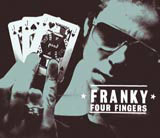Credit to the opening titles
Film titles, particularly animated sequences, are riding a new-found wave of popularity, but not everything in the sector is rosy. Hannah Booth reports

This is film season, in case you hadn’t noticed. The Baftas take place this Sunday, the Oscars exactly a month later on 23 March. But among the starry gongs for best picture and actor, you won’t find a best film titles category.
A shame, because titles are being talked about again, in particular the animated sequences for Steven Spielberg’s Catch Me If You Can, designed by Paris-based Kuntzel & Deygas and London production house Nexus. The retro style titles hark back to the so-called golden age of film title design of Saul Bass, Pablo Ferro and Maurice Binder and are setting new standards in motion graphics.
But what does the future hold for the industry? As commercial pressures cut budgets and squeeze deadlines, are film titles destined to become an afterthought rather than a creative contribution to the entire film-going experience?
Kemistry creative director Graham McCallum, responsible for titles such as Mansfield Park and Resident Evil, says film title sequences are ‘hugely important’.
‘They set up the whole movie. It’s the first taste of the film that the audience experiences,’ he explains.
But, he says, not all directors agree on the importance of a film’s opening sequence. ‘Some [directors] are hands-on and have a clear picture of how they want the film to start; others make do with film clips, music and the credits,’ McCallum says.
‘Titles can be the last thing to be considered. Directors put all their energy into the film.’
Worse, the growing penchant for testing a film with audiences can mean the titles have to be entirely redesigned, particularly if they closely reflect the plot.
Fig Productions founder and titles designer Richard Morrison agrees that persuading directors to invest in ‘stylish sequences’ can be a battle. Some directors, keen to involve title designers as early into the process as possible, bring him in up to three months before the end of the post-production process. Others only give him around six weeks’ notice.
Picasso Pictures’ motion graphics arm, So, has created titles for films including Guy Ritchie’s Snatch and director/ designer Stuart Hilton says much opening sequence work is ‘an after-thought’. ‘You are lucky if the director is visually led,’ he says.
With the Snatch titles, Ritchie said he wanted a snappy sequence, but left the creative decisions to the consultancy. Hilton says he was inspired by the ‘naive typography’ of promotional boxing posters – giant works with large, screen-printed stamps of colour.
Now, even in the three years since Snatch appeared, digital technology has moved on at such a pace that almost anything is possible in film. Does this mean creativity is suffering?
A look at the work of Kuntzel & Deygas, which combined traditional and contemporary methods on Catch Me If You Can, would suggest not. Animated titles in particular, it appears, are enjoying a renaissance.
Combining traditional stamp animation techniques with digital technology, the three-minute Catch Me If You Can titles sequence is a chase, mirroring the film’s theme as well as its 1960s setting.
Steven Spielberg’s DreamWorks approached Nexus after seeing its work for Virgin’s in-flight animated safety video, says Nexus co-founder Chris O’Reilly.
‘We tried to stylise the idea that people have now of the 1960s,’ says Nexus co-founder Charlotte Bavasso. ‘Back then, there were no computer graphic images. A title sequence was made with real images. We chose to use traditional drawings so as to keep as much sincerity and human touch as possible.’
Nexus and one of its directing teams, Vehicle, won best titles at last August’s Soho Shorts film festival for its animated sequence for British film, Miranda, starring Christina Ricci and John Hurt.
‘We are relative newcomers to film titles,’ insists O’Reilly. ‘Creatively, they are very interesting to work on, combining design and animation. And it’s a fertile ground for work, if you can get it.’
But getting work is becoming more difficult. Despite a creative upswing, some designers express concern about the state of health of the industry.
Morrison has recently created the opening sequences for Dirty Pretty Things and the forthcoming Nine Dead Gay Guys, a UK comedy that kicked up a fuss at Cannes last year. And last week, he started work on Bernardo Bertolucci’s new film The Dreamers, set in 1960s student-revolt Paris. He says he is fortunate to work extensively on films, and is the exception rather than the rule.
Not enough films are being made,’ says Morrison. ‘It was a fairly quiet year last year, particularly toward the end – the film industry, as any other, is suffering.’
As a result few consultancies are able to focus entirely on films. Most create titles, commercials, stings, bumpers, programme and channel idents and branding for the plethora of digital channels. So’s titles for Snatch comprise only a small percentage of its work.
‘Most titles work is incredibly low budget. It’s a treat if you get to work on them,’ says Hilton.
McCallum agrees. ‘There is not the volume of work to sustain a company doing nothing but film titles. [Only] around 20 per cent of films look to outsiders to create titles as a separate entity.’
Marc Ortmans is testament to the problems the industry faces. Last week, his television design and branding consultancy Ortmans Young wound up its operations after 15 years, due to the ‘difficult economic climate’.
‘Budgets have been slashed, there’s too much pitching going on and broadcasters are either cancelling or postponing work, or taking it in-house,’ says Ortmans. ‘Titles in particular are remarkably under-funded. Historically, they were superimposed typographic captions, not a design function. Work comes if directors are educated enough to invest in it.’
Maybe an Oscar category wouldn’t go amiss, either.
-
Post a comment




